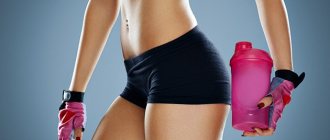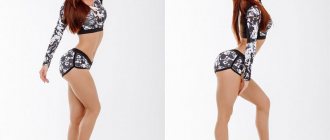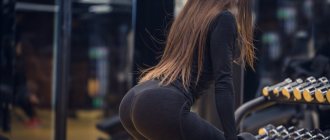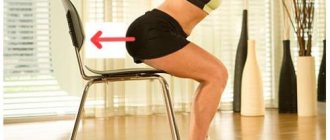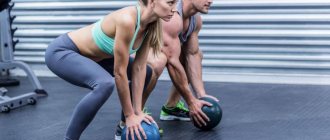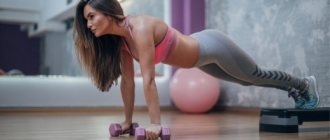An attractive figure is what every girl strives for. Many people start doing fitness just to get firm buttocks and lose excess weight. And if you are firmly focused on results, but do not have the opportunity to work with a trainer, we invite you to study the most effective exercises and workouts for your legs and buttocks, which are easy to perform at home without outside help.
- Basic workout at home, simple exercises for girls at home
- Classic squat
- Plie (type of squats)
- Lunges: classics of the genre
- Bulgarian lunges
- Bridge
- Have you heard anything about hyperextension?
- Swing your legs
- Squats with chair support
- Walking on your buttocks
- Training according to the program
- Circular trainings
Features of training the buttocks and thighs
The wrong approach to training can cause a lack of results. To avoid this, adhere to the following principles:
- Power load. We recommend that men select the weight of the weights so that in each approach they do 6-12 repetitions with effort on the last two, girls - 15-20;
- Frequency of classes. Men's lower body training should not be more than once a week. Women's training for legs and buttocks can be done 2 times a week with a break of 3-4 days;
- Program structure. Basic multi-joint exercises (squats, leg presses, etc.) should be performed at the beginning of the session, as they consume a large amount of energy;
- Technique. Don't try to quickly pump up your legs and buttocks. Learn how to perform basic exercises correctly. This way you will protect yourself from injury and will gradually progress.
- Variability of training. The muscles of the legs quickly “adapt” to monotonous exercises. Therefore, we recommend modifying your training plan every 8-10 weeks.
Basic workout at home, simple exercises for girls at home
No glute workout is complete without squats. There are several variations of this exercise, but all of them are aimed at working the gluteus maximus, hamstrings, calf muscles and back extensor muscles. Squats are performed both with your own weight and with weights. However, do not rush to grab the dumbbells. For the first month, it is recommended to perform any exercises without additional weight.
The goal of doing squats at home for beginners is to practice the technique. And if each workout is of the highest quality, taking into account the specifics of the exercises, you will very quickly achieve success in pumping up your hips, buttocks and legs.
Classic squat
IMPORTANT! Before performing basic exercises, do not forget to warm up. Do stretches throughout your entire body, stretch your legs and arms, and bend your torso. Warm-up should last at least 7 minutes. After that, we move on to squats:
- Place your feet wider than your shoulders, with your toes pointing to the sides.
- Do squats with a straight back, moving your pelvis back.
- Don't lower your head, try to look forward or up.
- Your knees should not protrude beyond your toes.
- Place emphasis on the entire surface of the foot, not on the toe.
- Inhale - lowering the pelvis, exhale - lifting.
Optimal number of approaches: 3 15–20 times.
Step-by-step squat instructions
Flat back, deep squat, toes and knees on the same vertical line!
Flat back, deep squat, toes and knees on the same vertical line!
Plie (type of squats)
In order to get rid of excess weight on the inner thighs, include the plie exercise in your workouts. After 1–1.5 months, use additional weight in the plie. So, you will give impetus to the development and growth of the gluteal muscles.
- Place your legs wide across the entire surface of your feet, with your toes, as in a classic squat, pointing to the sides.
- Bend your elbows and hold them in front of you (you can press them to your chest).
- Lower yourself with your back straight. Move your pelvis back.
- The more you move your toes to the sides, the more muscles will be involved in the exercise. It depends on your flexibility.
- Hands and body should be static.
- We pump 3 sets of 12 repetitions.
When performing plie, the biceps and quadriceps of the thigh and gluteal muscles should be tensed.
Plie. We train the muscles of the thighs.
Correct technique.
Correct technique.
If you are no longer a beginner, are ready for the next level and want to make the exercise more effective, use dumbbells (or kettlebells). The technique remains the same, only the position of the hands changes. When you take extra weight in your hands, keep them static, do not lower your shoulders or arch your back.
IMPORTANT:
- Be mindful of your posture. It should be perfectly straight.
- Follow the breathing technique: starting position - exhale, squatting - inhale.
- The knees should not go beyond the line of the socks (as in the “classic”).
- When raising your pelvis, do not bend your knees all the way, you can damage your joints.
- At each stage of the exercise, the gaze should be directed upward.
Plie with weights
Follow the technique!
Follow the technique!
Lunges: classics of the genre
An equally important exercise in leg training is lunges. They are not only popular, but they are effective! The literal, rectus, and gluteus maximus muscles tense to the point of burning! And this leads to rounding of the buttocks. At the same time, you get rid of cellulite and excess fat on the thighs. Lunges powerfully correct your figure, increase strength and flexibility.
Rules for execution (practice in front of a mirror to hone your technique to perfection):
- Take a step forward so that when you squat, your front leg forms a 90° angle.
- Lower yourself horizontally (straight back!) and squat on one knee.
- The leg that remains behind should form a larger angle.
- IMPORTANT! Don't touch the floor with your back foot!
- Keep your hands in front of you or on your belt (if with dumbbells, then at your sides).
- Look up!
You can start the exercise differently: from a standing position, move your leg back, not forward. The execution technique in this case remains the same. After a month of training, start using additional weights. Number of lunges and repetitions: 3 x 15.
Lunges
Correct execution
Correct execution
Bulgarian lunges
This type of lunge is performed using support (the edge of a sofa or chair): with or without weights. Active muscles: quadriceps, gluteal, gastrocnemius, soleus. The support here is used for balance and stability. Exercise increases the muscle volume of the buttocks, strengthens the leg muscles and helps reduce fat mass. Execution algorithm:
- Stand next to a sofa (or other support) and put one leg over the edge.
- Keep your arms close to your chest or, if you're using dumbbells, hold them in a natural vertical position.
- Take one step forward with your free leg.
- Begin to squat smoothly, forming a 90° angle at the knee.
- Number of approaches: 3 x 12 repetitions.
Active muscles during lunges
Correct technique
Correct technique
To pump up not only the inner part of the thigh, but also the outer one, the lunge technique can be complicated. To do this, we change the position of the legs from “classical” to cross. For this:
- Do a “curtsey”: bring one leg forward diagonally, turn your toe towards the knee.
- Take the other leg back, the toe should point forward.
- The front knee forms a 90° angle.
- Squat down slowly, keeping your body straight.
- Switch legs to the other after 12 repetitions.
- Number of approaches: 3.
Lunges "Curtsey"
Correct technique
Correct technique
Bridge
This exercise can have a comprehensive effect on the leg muscles. You will not only pump up your buttocks and thighs, but also create a beautiful silhouette of your figure as a whole. The gluteal, thigh (back and front), and calf muscles experience particular tension. The exercise is good for the lower back and spine. It will accelerate blood circulation and stabilize blood pressure.
- Lie on the floor (if you have a gymnastics mat, use it).
- Place your legs on your knees, emphasis on your feet.
- Place your hands along your body, palms down.
- Begin to lift your pelvis up, resting on your shoulders and part of your shoulder blades.
- Try to arch your back as much as possible.
Number of approaches: 3 x 20 repetitions.
Gluteal bridge
Correct technique
Correct technique
One type of glute bridge is the one-leg bridge. This exercise is more difficult, but it makes most of the muscles “burn”, including training flexibility and endurance. To begin, lie on the floor and place your feet on your feet (as in a classic bridge):
- Raise one leg up, try to straighten it at the knee.
- Focusing on your arms and shoulders, lift your body up.
- Pull your toe with your outstretched leg.
- Smoothly lower your body and change legs.
- Number of approaches and repetitions: 3 x 12.
Type of gluteal bridge
The exercise is performed on one leg
The exercise is performed on one leg
Have you heard anything about hyperextension?
This special exercise will help relieve tension in your back and lumbar region throughout your workout. It will strengthen muscles, increase strength coefficient, and promote the development of flexibility. In the gym, the exercise is performed on a Roman chair, but at home it can be done directly on the floor. In this case, not only the back muscles are involved in the work, but also the thigh biceps and gluteal (large and small) muscles.
Option 1.
- Lie on your stomach with your arms extended in front of you.
- Straighten your legs and point your toes.
- Lift your back up, stretch your shoulders and arms up.
- Raise your legs at the same time without bending your knees.
- Do the exercise slowly, without jerking.
Option 2.
- In a lying position, place your arms along the body (at the seams).
- Focus on your toes. In this case, your legs should remain static.
- Work only with your torso: rise and fall smoothly.
- Number of approaches: 4, number of repetitions: 10.
Types of hyperextension
Ideal execution technique
Ideal execution technique
Swing your legs
You can get rid of excess weight on the front and back of your thighs, round your buttocks, improve blood circulation, develop flexibility and plasticity with the help of regular swings. There are several types of this exercise: swings with a straight or bent leg, supported on the palms or elbows, swings forward and backward, to the sides. But all of them are aimed at working the gluteus maximus and medius muscles, as well as the quadriceps of the thigh.
Option 1. Bent leg.
- For this exercise you need to get on all fours with emphasis on your palms (elbows) and knees.
- Do not lower your head, your gaze should be directed upward.
- In this position, lift one leg by bending your knee.
- The higher you raise your hip, the better the muscles will tighten.
- Follow the technique: do not make sudden movements, lift your leg with the strength of your gluteal and thigh muscles.
Swing option No. 1
Correct technique
Correct technique
Option 2. Straight leg.
- Swings are performed from the same position with emphasis on the hands and knees.
- Move your leg slightly back and up without bending your knee.
- Feel your calf muscles and hamstrings tighten.
- Try to pull the toe up.
Swing option No. 2
Straight leg technique
Straight leg technique
Option 3. Swing forward and backward.
- For this exercise you will need support (the back of a chair or the edge of a window sill). But if you can maintain your balance, place your arms along your body to help you balance.
- Stand next to a support (for belay).
- Take your straight leg back and then move it forward and up.
- The greater the swing amplitude, the more you engage the gluteal muscles.
The optimal number of approaches for each exercise is 4 x 20 times.
Swings supported on the back of a chair
Correct technique
Correct technique
Squats with chair support
The purpose of the exercise is to increase the volume of the buttocks, give them a rounded shape, and strengthen the posterior thigh muscles. The main feature is that squats are performed using a vertical support (wall). This type of squats can be included in your training program if you are bored with the usual basic exercises. But the base cannot be completely excluded. Just supplement the classic exercises, increase the load, the number of approaches or repetitions.
Supported squat technique. Option 1:
- Press your shoulder blades and pelvis against the wall.
- Place your feet slightly wider than your shoulders, toes pointing up.
- Slowly lower your body down, literally “sliding” down the wall.
- Once your knees are at a 90° angle, slowly rise to the starting position.
- Keep your hands in front or at your sides at all times.
- Use weights: dumbbells or water bottles.
Option 2:
- Using the same position, press your upper torso against the wall.
- When lowering your pelvis down, bend one leg at the knee and lift it forward.
- Press your palms against the wall for better balance.
- The gaze should be directed upward (maintain a straight posture).
Number of approaches: 3 x 12 repetitions.
"High Chair" options
Execution technique
Execution technique
Walking on your buttocks
After a good workout of the gluteal muscles, there is a need to strengthen them. An effective exercise for this is walking on your buttocks. The exercise has been practiced for a very long time and it is popular not only among ordinary girls and women, but also in professional sports. From a medical point of view, this can be used to prevent a number of intestinal-related diseases. But the main goal is still pumping the buttocks and strengthening the muscles.
- Sit on the floor, take a natural position of your legs.
- Bend your arms at the elbows and press them to your body.
- Straighten your shoulders and back.
- Focus on your pelvis and lift your legs.
- Start moving with your buttocks, helping you balance with your arms and legs (but don't touch the floor with them).
- Move from one wall of the room to the other.
- Number of approaches: 4.
Walking on the gluteal muscles
Correct technique
Correct technique
Examples of training programs for men and women
Note that it is almost impossible to pump up your butt and legs at home. The maximum that can be achieved is a beautiful relief of the lower body, muscle tone and a reduction in fat. Therefore, the proposed programs are designed for training in the gym.
Strength program for men
Performed once a week in combination with other workouts for the back, chest, and shoulders.
- Warm up on a treadmill or with a jump rope (5-7 minutes);
- Barbell squats (4/6-8);
- Forward lunges with kettlebells (3/10-12);
- Leg press (3/10-12);
- Romanian deadlift (3/10-12);
- Leg extension while sitting in a machine (3/10-12);
- Lying leg curls in the simulator (3/10-12).
We recommend finishing your lower body workout with light stretching. This will help you recover faster and reduce your soreness.
Legs and buttocks training for girls
The program can be performed twice a week, for example on Monday and Friday. At the same time, it is advisable to train the rest of the body muscles on free days.
- Warm up on a treadmill or with a jump rope (10-15 minutes);
- Smith machine squats (4/15-20);
- Cross lunges with dumbbells (3/15-20);
- Plie squats (3/15-20);
- Bulgarian lunges with dumbbells (3/15-20);
- Weighted gluteal bridge (3/15-20).
If you are overweight, we recommend finishing your session with an aerobic cool-down, such as pedaling an exercise bike or jumping rope for 15 minutes.
Anatomy of the main muscles of the legs
We will not consider in detail all the muscles of the legs (there are more than a dozen of them), we will focus only on those muscles whose target development interests us.
Gluteus maximus muscle
Anatomy of the gluteal muscles
This muscle is attached to the sacrum and coccyx from the inside, and to the upper part of the femur from the outside. The volume and beautiful shape of the buttocks depends 80% on the degree of its development. The main functions of the gluteus maximus muscle are extension of the torso at the hip joint and abduction of the legs back, as well as stabilization of the body when walking and running.
Quadriceps
Anatomy of leg muscles
The quadriceps is the largest muscle in the human body, and the one that male bodybuilders spend the most time developing on leg day. Hypertrophied quadriceps give the legs extraordinary volume, especially in the front of the thighs. The main functions of this muscle are to extend the leg at the knee joint and move the pelvis forward.
Biceps
Biceps femoris
The biceps femoris, being an antagonist of the quadriceps, performs the opposite function - bending the leg at the knee joint and moving the pelvis back. It is located on the back of the thigh, stretches from the buttocks to the knee joint. Works in conjunction with the gluteus maximus muscle.
Calf muscle
Calf muscles
This muscle originates at the bottom of the femur, runs along the back of the tibia, and ends at the Achilles tendon. The main task of the gastrocnemius muscle is to flex the leg at the ankle joint and rotate the foot.
Bulgarian tilt
Starting position: straight stand with arms down along the body. One leg in a relaxed state is placed back, the body leans forward until a straight line is formed, parallel to the floor.
During the exercise, the arms are pressed to the body, bent at the elbows. For each leg you need to do 15-20 bends.
Don't miss the most popular article in the section: Morning exercises for those over 40, 50. Gymnastics exercises for weight loss, video lessons.
Dietary recommendations
Sometimes fullness of the legs is due to excess muscle mass (for example, in speed skaters). But it is quite difficult to remove the muscles on the legs, so we recommend training for girls to lose weight. Along with fat, muscle fibers will gradually burn. But to start the fat burning process, you must adhere to the following recommendations:
- Avoid “fast” carbohydrates (sugar, confectionery, sweet drinks);
- Avoid baked goods made with white flour. Replace them with whole grain bread;
- To speed up your metabolism, eat smaller meals: 4-6 times a day in small portions;
- Eat all carbohydrates (porridge, cereals) in the first half of the day. In the evening, instead of a side dish, eat vegetables;
- Balance your diet. Recommended combination of BZHU for fat burning: 30%/25%/45%, respectively.
How to practice?
Simple recommendations will help you make your workouts effective and safe.
- Do not make sudden movements, everything should be smooth and even. If you can't lift the weight without jerking, take a smaller one.
- Be sure to warm up your muscles with a simple warm-up and 5 minutes of cardio.
- Breathe correctly: take deep breaths through your nose, exhale through your mouth.
- Watch your posture, correct placement of your feet and other techniques. At first, it may be better to practice in front of a mirror and with a trainer to remember which muscles you should feel and where.
- Drink water. A little bit, 1-2 sips, but every 15-20 minutes or more often. Water is important for the skin, and no matter whether you are losing weight or pumping up muscles, the skin must be hydrated, otherwise it will sag and stretch marks.
Exercises for calves (shin)
Standing calf raise in the machine
Basic exercise for “pumping” the calf muscles. Recommended to be performed at the end of your workout.
Pros and cons of the exercise:
| Suitable for those who have long dreamed of massive and sculpted calves and are willing to spend time training them in isolation |
| The exercise can only be performed in a special simulator, which is not available in every gym. |
Donkey calf raise
Donkey calf raise
Used by athletes to develop calf muscles in the absence of the necessary equipment. A partner is used as a weight, who sits on the athlete’s back.
Pros and cons of the exercise:
| Electromyography studies have shown that this exercise is 25% more effective for working calves than regular standing calf raises. |
| Performed without the use of special projectiles |
| You need a partner who agrees to “ride” you |
Contraindications
Despite the fact that reasonable physical activity is beneficial for the back, in some cases it may be contraindicated. For example, you should not perform exercises in the first stages of any spinal disease, as this can cause a deterioration in the body’s condition.
Attention! It is important to perform only those exercises that your doctor recommends. Improper physical activity can negatively affect the condition of the back and worsen the situation.
If the load is incorrect, the situation may worsen
Also, you should not perform gymnastics during exacerbations of a number of diseases. This may make the situation worse. It is also prohibited to do exercises if you have an elevated body temperature or a general negative health condition. You should also not exercise if you have ARVI, influenza, or other similar diseases.
A number of oncological diseases can also be an obstacle to back treatment with gymnastics. The thing is that any neoplasms negatively affect the body as a whole, and sometimes it is unknown how the body can react to exercise.
Oncological diseases are one of the contraindications
Classic forward/backward lunges
The basic forward lunge exercise is performed as follows:
- the legs should be shoulder-width apart with a straight stance, the back should be straight, the chest should be straightened and the arms should be lowered along the body;
- the working leg is put forward with a wide step, bent at the knee - the supporting leg is lowered, almost touching the floor;
- returning to the starting position, the back leg must be placed next to the front;
- the next lunge is performed with the other leg.
You need to do 5-6 lunges, straining your abs. Back lunges are performed in the same way: the leg is tilted back at an angle of 90° and squats are performed.
Reverse hyperextension
You can perform reverse hyperextension on a machine, bench, or Roman chair.
- Starting position: lie on the surface with your stomach, lowering your legs so that they do not touch the floor. Tighten the muscles of the buttocks and the back of your legs. You need to firmly grasp the machine with your hands.
- Exhaling air, raise your legs to maximum muscle tension. When lifting, your legs should be in line with your body.
- Hold the position for 3-5 seconds. Inhalation is done while lowering the legs to the starting position.
You need to repeat the exercise 10-15 times in 2-3 approaches. The break between approaches is 1 minute.
Gluteal bridge
To perform a bridge, you need to lie on your back, leaning on your legs, bent at the knees.
Hands are placed freely along the body.
- Exhaling deeply, you need to raise your pelvis so that your back and legs create an even diagonal line.
- In the upper position, you should tense your buttocks as much as possible, without relaxing them when lowering.
- As you inhale, gently return the pelvis down.
